![]()
Alexander Murray: 1844-1907
Alexander Murray was the second child and eldest son of Abijah and Elizabeth Murray. He was born in Edinburgh on 22 June 1844 and received his education there. At an early age he entered the warehouse of Duncan McLaren, a well-known soft goods merchant and later on he joined his uncle, Ebenezer Murray, and eventually became a partner in the firm of Dalgleish and Forrest, furniture warehousemen. As a young man he took a keen interest in temperance reform and became president of the Edinburgh Total Abstinence Society, a position he held until he left Scotland for the colonies.
Alexander's wife was Margaret Brown Darling, daughter of Mr James Darling, a well-known Edinburgh businessman who established Darling's Regent Hotel in Waterloo Place, Edinburgh. The couple had six children, two of whom died before they were one year old: Ernest Lough Murray who was born in 1879 and died in 1880; and Elizabeth Sneyd Murray, born in 1882 and died in 1883. The surviving children were:
daughters Isabella (1881-1941) and Annie (1888 - ?).
All four of the surviving children had the middle name "Darling". Isabella (Bella) married George Lamont Berrie; and Annie married Frederick George Pickburn.
Alexander, Margaret and the twins emigrated to the colony of Queensland (Australia) in 1876. Alexander held good positions with many firms in Brisbane, including Messrs Stewart Dawson & Co; Benjamin Brothers; Watson, Ferguson & Co; and the New Swanbank Colliery Ltd where for several years he was secretary and city manager. He was also well known in Masonic and temperance circles. He was Assistant Grand Secretary of the District Grand Lodge of Scottish Freemasons of Queensland, and also Provincial Grand Scribe E of the Provincial Royal Arch Chapter of Queensland SC.
In the mid 1890s he became associated with the Reverend Jarvis B Johnson, on his arrival in Brisbane, and he took a keen interest in the mission work which Rev Johnson was doing. Apparently it was at Alexander's suggestion that the Rev Johnson established the Joyful News Mission, and Alexander maintained a close association with the mission for about 12 years. He occupied the position of Treasurer for over 10 years and taught the senior girls' Bible class.
Alexander died on 9 January 1907 aged 62. His obituary notice records that he "had been ailing for some time, but did not leave work until the end of 1906. He became seriously ill on Sunday 6 January, but on Tuesday 8 January, when he was visited by Rev Johnson, he appeared to have improved, so much so, in fact, that he was up for a time. He retired on Tuesday night in good spirits, but when his family entered his room on Wednesday morning it was found that he had passed away in his sleep." Apparently among his last words were "Give my love to all in the mission."
Sadly, his wife's sister, whom he hadn't seen for 31 years, had arrived in Queensland from Edinburgh only a week earlier, accompanied by her niece, Miss Deas.
At the time of his death Alexander was living at Regent House, Le Geyt Street, O'Connell-town, Windsor. Before the funeral cortège left the house Rev Johnson conducted a brief memorial service. He also read the burial service at the graveside in Brisbane's Toowong Cemetery, the largest in Queensland.
Margaret outlived her husband by 22 years, passing away in Brisbane on 22 August 1929 aged 77. She too was buried in Toowong Cemetery. Read an obituary of Margaret here.
Alexander's twins Abijah and James
The twins Abijah and James were born in Edinburgh in 1875. A year later they sailed for Queensland with their parents. They were predominantly educated in Australia, although they were briefly sent back to Scotland to spend a term or two at George Watson's College in Edinburgh to reinforce their Scottish heritage.
Both boys qualified as solicitors and entered practice in Queensland, James in the central Queensland mining centre of Mount Morgan and later in the coastal city of Rockhampton; and Abi (as he was known) in far north Queensland.
Abijah
Abi was admitted in December 1897 and practiced as a solicitor and notary public at Thursday Island, just off the northern tip of the continent, for eight years.
On 14 May 1906 he joined a law practice in Cairns which had been set up a few years earlier by Charles Bedell Lilley. The first record of this practice dates from 13 May 1899. Charles and Abi became partners and the practice became known as Lilley and Murray.
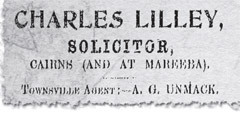
In commenting on the establishment of the partnership The Cairns Morning Post said "the firm would undoubtedly secure their share of business in this town and district".
While most of the legal work was mundane, the partners acted in several significant cases in the district. In 1909 Abi travelled to Geraldton (Innisfail) to act on behalf of several sugar mill hands who were summonsed for alleged breach of contract. He was also engaged to act on behalf of the Great Northern Company, a mining company that was accused by E.G. Theodore in the State Parliament of corruption. Lilley and Murray were retained as solicitors to the Cairns Harbour Board after the Board was established in 1906. In addition to offering general legal advice, Lilley and Murray represented the Board in many legal actions. The firm continued to act for the Cairns Harbour Board for nearly 75 years.
Abi led a busy social life. He was a member of the Masonic fraternity in North Queensland, holding many positions including Grand Inspector of Masonic Workshops and representative of the Grand Lodge of Illinois. He was a keen lawn bowler and was a founding member of the Cairns Bowls Club. He was involved with the Cairns Jockey Club where he acted as a committeeman. He was also a Lieutenant in H Company in the local militia, and advocated universal military training.
Abi suffered a devastating loss in March 1911, when the coastal steamer Yongala foundered in the eye of a cyclone off Townsville while sailing from Brisbane to Cairns. The ship, a luxuriously appointed passenger and freight vessel, sank without trace on 23 March with the loss of all passengers and crew. Abi's wife, Minna, and their four children were aboard the Yongala* , travelling first class along with Mary Linedale, an Aboriginal maid who was assisting Minna. Mary's husband worked as Abi's man-servant. The children were Ian (6); Alister (5); Jessie (3); and Ailsa Mary (8 weeks), whom Abi had not yet seen. Minna had travelled to the Blue Mountains in New South Wales to escape the heat during the final stages of her pregnancy with her Ailsa. She had waited until the new baby was 8 weeks old before returning from Sydney.
After the loss of his family Abi, who was 36 at the time of his bereavement, went south for some time. He returned to Cairns in August 1912 and met Hilda Mary Sydes, a young teacher who had found her way there from Tasmania. The couple married on 18 December 1913 in the Cairns Presbyterian Church.
They had six children, only one of whom - a daughter, Heather (1915 - 2001) - reached adult life. One son, Robert, born in 1918, died in infancy as the family were on their way to Tasmania, presumably to visit Hilda's family there. He contracted a viral infection, possibly measles or even influenza, carried back from Europe by soldiers returning from the First World War.
In April 1915 a notice in The Cairns Post advised the dissolution of the partnership of Lilley and Murray. Lilley had been suffering poor health for some time and decided to move to Brisbane. A Deed of Dissolution to end the partnership was issued on 24 May 1915 and for some time after this Abi advertised only under his own name.
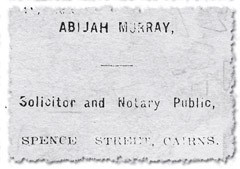
In November 1915 Abi was ordered to proceed to Enoggera Barracks to serve in the army. While he was away he arranged for Herman H Marsland to take over his practice. Before he left Cairns, Abi was farewelled by the Cairns Jockey Club and the Cairns Bowls Club. The members of both organisations well knew his addiction to tobacco, and he was given a case of pipes at each farewell party. Lieutenant Murray left Cairns on the Arrawatta to travel to England.
After he returned from the war, Abi went into partnership with Marsland. The partnership of Murray and Marsland endured until about 1918, when Marsland left the firm.
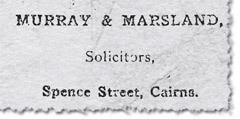
In March 1927 an advertisement appeared in The Cairns Post for Murray and Bennett, Solicitors. Joseph Bennett came from a Cairns family and passed his solicitor's examination in Brisbane in 1907. He set up practice in the A.M.P. building in Cairns in 1910. He had acted as a junior partner with Lilley and Murray before going south to practice but returned to Cairns in 1912 and carried on a sole practice until he joined Murray.
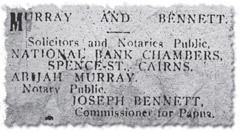
Abi Murray died at the age of 57 in the Cairns District Hospital on 11 December 1932 from a cerebral haemorrhage, and was buried in the Cairns Cemetery. The words on his gravestone read "Life's labour done serene to his final rest he passed."
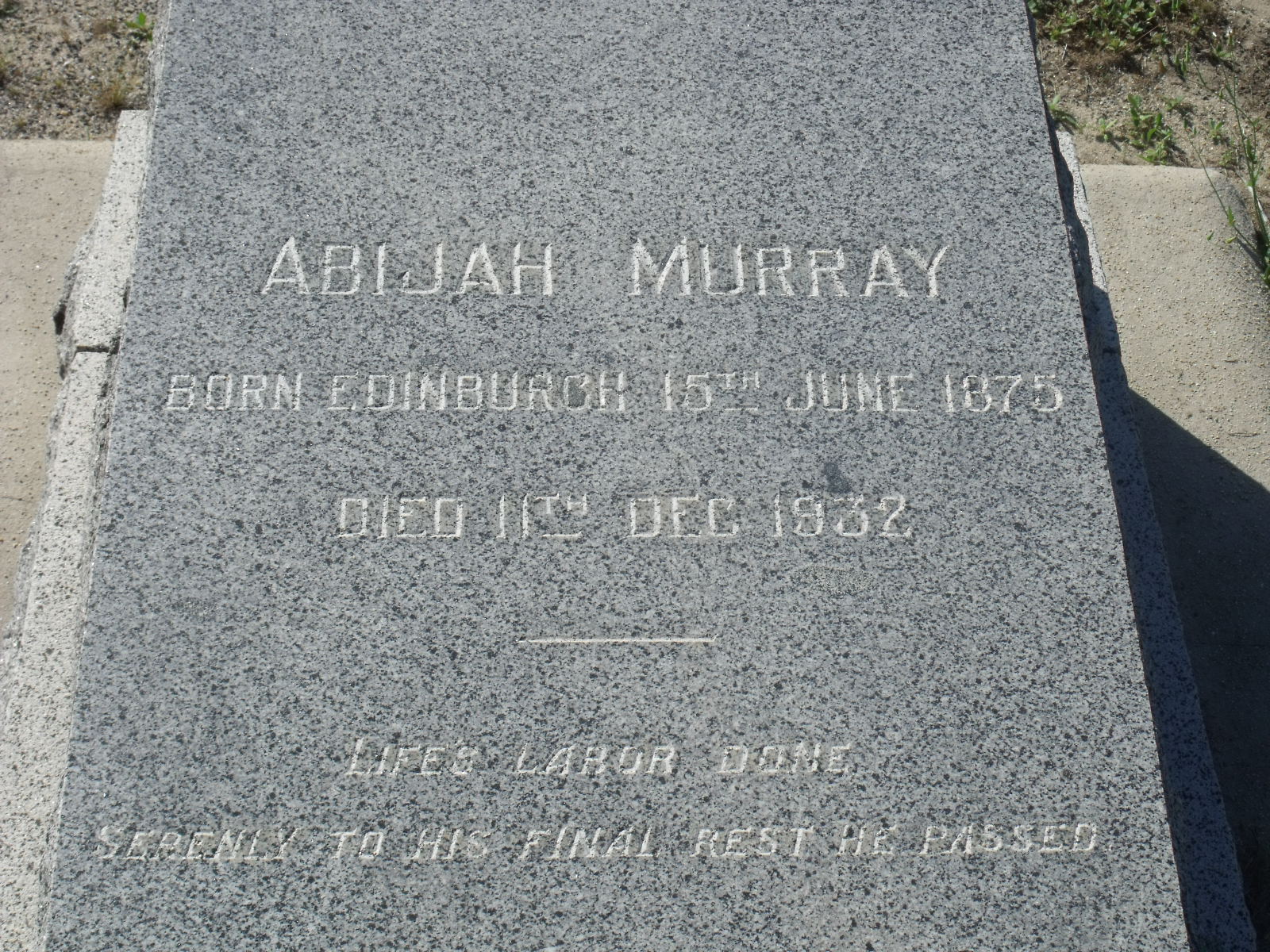
After Abi's death his widow Hilda and their daughter Heather moved south to Brisbane, where Heather met and married a GP, Charles Lawrie. They had three sons, all of whom qualified in Medicine, and a daughter who graduated in law, became a solicitor, later a barrister and eventually a Justice of the Family Court of Australia.
James
James married Diana Harriet Hirst and the couple had 6 children:
Colin Hirst Murray (1906-1972), married Joyce Marie Hamwood.
Arthur Druce Murray (1908-1991), married Mary Roberts (1916-1987).
Abi Sheppard Murray (1913-1991), married Ellen Harriet Knyvett on 19 November 1938.
Diana Elsie Darling Murray (1917-1976); and
Grace Darling Curtis Murray, born in 1920.
James died on 20 May 1948, aged 72. He is buried in North Rockhampton cemetery. His wife Diana died in 1966.
*The Yongala
The Yongala was a steel steamer owned by the Adelaide Steamship Company. Built and later launched in Newcastle upon Tyne, England, in 1903, the 3700 tonne S.S. Yongala was named after a tiny South Australian pastoral town of the same name. Yongala means "good water" in the local Ngadjuri language. It plied the waters off the east cost of Australia from Melbourne to Cairns.
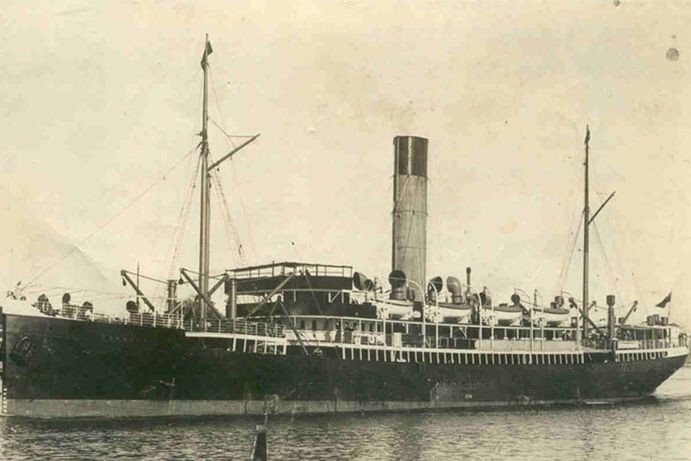
On 14 March 1911, under the command of Captain William Knight, Yongala embarked on her 99th voyage in Australian waters. She left Melbourne with 72 passengers, heading for Brisbane, where she arrived on 20 March. There most of the passengers from Melbourne disembarked, and new passengers and cargo, including the racehorse Moonshine and a Lincoln Red bull, were loaded. A harbour inspection found Yongala to be "in excellent trim", and she sailed for Mackay, where she was due on 23 March.
Despite delays in Brisbane, Yongala arrived in Mackay as expected on the morning of 23 March. After the transfer of passengers and cargo, the ship sailed north for Townsville at 1:40 pm, carrying 49 passengers, 73 crew and, supposedly, 617 tons of cargo in the lower hold, including Moonshine and the prize bull. What the ship's master didn't know was that shortly before the vessel had left sight of land at Mackay, a telegram was received by the Flat Top signal station warning of a tropical cyclone between Townsville and Mackay. Flag and wireless signals from the station prompted several ships to take refuge at Mackay, but Yongala did not see the flags, and was yet to be fitted with wireless equipment as its brand new Marconi radio was still on its way from England.
Five hours after setting sail the frustrated lighthouse keeper at Dent Island could only watch her sail into the Whitsunday Passage. He was the last person to ever see the Yongala.
In the raging cyclonic seas, waves broke over her side, immediately filling the Yongala with water and sending her quickly to the bottom.
Three days later, concern escalated and Yongala was posted as missing. Every possible vessel was thrown into the search, but apart from some debris washed up on the beaches, no trace was ever found. It remained one of Australia's biggest maritime mysteries for decades.
The only body ever to be recovered from the wreck was that of of Moonshine. The doomed racehorse washed up at the mouth of Gordon Creek, three miles south of the Ross River, near Townsville.
After it sank the Yongala lay undisturbed for nearly 50 years and wasn't identified until 1958. It still lies in the Great Barrier Reef Marine Park near Townsville and is one of the top ten wreck dives in the world.